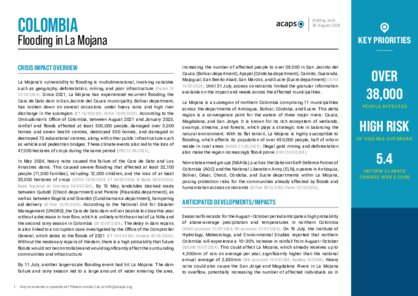Latest updates on country situation
11 November 2024
Heavy rains in Colombia have led to widespread flooding in recent weeks, affecting over 230,000 people by 11 November 2024 and forcing the Government to declare a national state of disaster. The hardest-hit areas include Chocó department in the west, where riverine flooding has restricted mobility and isolated towns, and La Guajira department in the north, where heavy rains have blocked main roads and destroyed Indigenous communities' crops. People in both departments require humanitarian aid to access food and healthcare services. (CNN 10/11/2024, France 24 11/11/2024, El Colombiano 10/11/2024)
20 May 2024
2023 recorded 58,469 people displaced and 100,402 people confined in Colombia, a 14% decrease and 43% increase, respectively, compared to 2022. Clashes between non-state armed groups and insecurity were the primary causes behind both. Departments such as Cauca, Chocó, and Valle del Cauca, in western Colombia were the regions most affected. Those currently displaced and confined require access to food, WASH services, shelter, and ways to return to their homes and daily lives. (UNHCR 20/05/2024, IDMC accessed 21/05/2024)
04 March 2024
Despite a slight improvement in violence indicators, Colombia continues to grapple with humanitarian challenges. In January 2024, 12,600 individuals experienced displacement or forced confinement, primarily in the west. Of these, 8,600 were confined (69%) and 3,900 displaced (31%). Chocó witnessed the highest confinement rates, with up to 35,000 affected individuals in 2023. In Caquetá, 36,000 individuals faced mobility restrictions because of an armed strike earlier in 2024. Confrontations among armed groups and with state forces remain the primary cause of displacement and confinement. The affected populations, particularly those confined, urgently require access to food and protection from violence. (OCHA 01/03/2024, Radio Nacional 15/02/2024)
05 February 2024
In the northern Colombian department of La Guajira, 77% of rural households do not have access to clean drinking water and WASH services, putting them at a higher risk of contracting waterborne diseases and diarrhoea. In 2024, 260,000 people are estimated to require food assistance in the department, with 46% (120,000) coming from indigenous communities. These groups require humanitarian assistance in accessing food, drinking water, and WASH services. (OPS et al. 05/02/2024; FSC/Nutrition Cluster 03/01/2024)
29 January 2024
According to the National Unit for Disaster Risk Management of Colombia, wildfires, floods, displacement, and water shortages affected over 100,000 people in January 2024. The disaster unit attributed the natural hazards to the warmer temperatures generated by the El Niño-Southern Oscillation. Affected people require access to healthcare services (in response to the heat-related health emergencies resulting from warmer temperatures), fresh drinking water, and shelter. (UNGRD 29/01/2024, ERCC accessed 01/02/2024, El Colombiano 26/01/2024)
17 January 2024
At least 520,000 migrants and refugees entered the Darien Gap in Colombia and crossed to Panama in 2023, the highest number to date. Most of them crossed in August (81,946) and September (75,268). One-fourth (113,180) were minors, a high percentage of whom were under five years old and many of whom were unaccompanied. More than half of the total came from Venezuela (328,650), followed by Ecuador (57,250), Haití (46, 422), and China (25,565). To 90% of these migrants and refugees, the start and end points for crossing the Darien Gap were the town of Acandí in northeastern Colombia and the towns of Bajo Chiquito and Lajas Blancas in southern Panama. Their main needs in 2023 were access to WASH services, protection, education, food, and health assistance. (UNICEF 11/01/2024, MSF 1/09/2023, Govt. Panama 16/01/2024)
06 December 2023
In early November 2023, flooding affected more than 12,000 people in northern and central Colombia. The town of Maicao in La Guajira department near the northern border with Venezuela recorded the highest number of people affected (4,852). The affected population requires immediate assistance in the form of food, shelter, and clothing. (OCHA 05/11/2023, LGH 06/11/2023)
current crises
in
Colombia
These crises have been identified through the INFORM Severity Index, a tool for measuring and comparing the severity of humanitarian crises globally.
COL001 - Complex crisis
Last updated 14/11/2024
Drivers
Socio-political
Conflict
Violence
Floods
Displacement
Crisis level
Country
Severity level
4.1 Very High
Access constraints
3.0
COL002 - Venezuelan refugees
Last updated 14/11/2024
Drivers
Displacement
Crisis level
Country
Severity level
3.2 High
Access constraints
2.0
REG002 - Venezuela Regional Crisis
Last updated 18/06/2024
Drivers
Crisis level
Regional
Severity level
3.7 High
Access constraints
3.0
Analysis products
on
Colombia
02 December 2024
Colombia: Individual displacement in Bogotá, Buenaventura, Florencia and Ocaña
DOCUMENT / PDF / 7 MB
This report aims to assess the needs of IDPs experiencing individual displacement because of conflict in Colombia, with a specific focus on the municipalities of Bogotá, Buenaventura, Florencia, and Ocaña.
Attached resources
06 August 2024
Colombia: drought and flooding in the Orinoquia region
DOCUMENT / PDF / 635 KB
The onset of El Niño in Colombia in November 2023 led to dry conditions in the Orinoquia region. These conditions resulted in food insecurity, water shortages and rationing, and wildfires, affecting an estimated 195,000 people, predominantly in Arauca department.
Attached resources
02 August 2024
Colombia: Flooding in La Mojana
DOCUMENT / PDF / 1 MB
Since 2021, La Mojana has experienced recurrent flooding; the Cara de Gato dam in San Jacinto del Cauca municipality, Bolívar department, has broken down on several occasions under heavy rains and high river discharge in the subregion.
Attached resources
24 June 2024
Colombia: increased forced displacement in Neiva
DOCUMENT / PDF / 932 KB
Since the beginning of 2024, as a result of escalating conflict and violence, the Neiva municipality has seen an influx of IDPs from surrounding municipalities, 95% of whom have been forcibly displaced.
Attached resources
13 May 2024
Colombia: economic hardships and climate hazards in San Andrés
DOCUMENT / PDF / 874 KB
This report aims to inform humanitarian programming in Colombia, including ACAPS’s donors, to anticipate the potential developments derived from the compounding of climate hazards and economic vulnerability.






